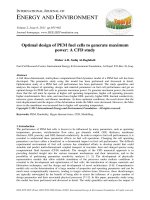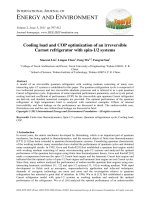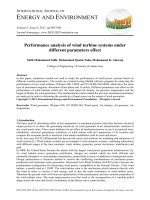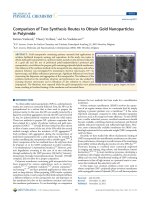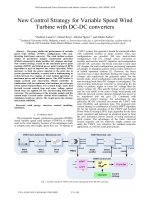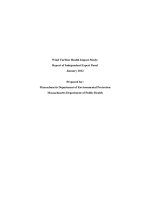Design of an omnidirectional wind turbine with kinetic storage
Bạn đang xem bản rút gọn của tài liệu. Xem và tải ngay bản đầy đủ của tài liệu tại đây (509.71 KB, 9 trang )
International Journal of Mechanical Engineering and Technology (IJMET)
Volume 10, Issue 12, December 2019, pp. 343-353, Article ID: IJMET_10_12_037
Available online at />ISSN Print: 0976-6340 and ISSN Online: 0976-6359
© IAEME Publication
DESIGN OF AN OMNIDIRECTIONAL WIND
TURBINE WITH KINETIC STORAGE
Fabian Valero, Hoffman F. Ramírez, Mauricio Mauledoux
DAVINCI Research Group, Mechatronics Engineering Department,
Military Nueva Granada University, Bogota, Colombia
ABSTRACT
The document in description is the writing of one of the strategies designed to
obtain wind energy and transform it into mechanical energy with its respective kinetic
storage, showing the items for the realization of the prototype such as the stages of
research, conceptual design and subsequent the final design, applied to scale.
Keywords: Design stages, wind energy, mechanical energy, kinetic storage.
Cite this Article: Fabian Valero, Hoffman F. Ramírez, Mauricio Mauledoux, Design
of an Omnidirectional Wind Turbine with Kinetic Storage. International Journal of
Mechanical Engineering and Technology 10(12), 2019, pp. 343-353.
/>
1. INTRODUCTION
Currently, alternative energy sources are being pushed aside from fossil fuels, being the
gateway to the strongest incursion of energetic natural sources.
Based on the foregoing, a system that can transform wind energy into kinetic rotation and
this time its storage in the same way is proposed. According to this, an investigation based on
two parts was carried out: the transformation of wind energy to kinetic and the kinetic storage.
1.1. Wind Turbines
For the transformation of wind energy, use wind turbines, in this group of devices there is a
great variety, the efficiency with which it is intended to develop, the workspace, etc. These
systems are divided into two large groups: horizontal axis (HAWT) and vertical axis
(VAWT); Depending on your application, it may be necessary or drag the movement.
HAWT (Horizontal axis wind turbine) [1, 2]: for this type of turbines, many variations
must be taken into account for the design and installation, such as:
Orientation
Number of Wings
Area
VAWT (Vertical Axis Wind Turbine) [3, 4]: among the different types of vertical axis
wind turbines there are three main ones:
/>
343
Fabian Valero, Hoffman F. Ramírez, Mauricio Mauledoux
Savonius
Darrieus
Rotor H or Giromill VAWT.
Figure 1 shows the arrangement for the assembly of a wind farm, having about 87 turbines
and approximately 145 square kilometers [5].
Figure 1. United Kingdom Wind Farm
The scale at which these parks are built is in the order of hundreds of meters high and for
the blades they can exceed 3 tons.
1.2. Kinetic Stores
Among the mechanical energy stores there is compressed air, hydraulic pumping and flywheel
[6].
Inertia Flyer: it is one of the systems that is based on maintaining a rotating mass and
continues to keep friction with other objects to a minimum so that there is no loss of energy,
even so, it is much more expensive to manufacture than a lead acid battery, but its state of
charge to discharge can have a variation of only a few seconds (figure 2).
One of its disadvantages is that storage and energy is contained in the same actuator and
that is where one of the main disadvantages of this type of storage can be observed, but even
more so, it is mostly used as an aid to other subsystems and not as a main source.
Figure 2. Storage system by flywheel.
/>
344
Design of an Omnidirectional Wind Turbine with Kinetic Storage
Hydro Pumped: in this type of storage, what is done is to let the water flow through an
underground conduit to make a turbine move while the fluid is passing through it has a flow
rate which is determining how much angular velocity it is that it is required to move the
turbine.
The efficiency and losses is linked to both the friction generated by the turbine and the
evaporation that the water has in the recirculation.
This type of energy storage is the most mentioned and the one that is commonly this
construction is usually this type of reservoirs are connected to a river in which this amount of
water can be discharged in the process does not affect, usually for this process not There is a
major innovative process in which an innovative process can be focused.
Despite this one of the largest hydroelectric plants in the world is China called the Three
Gorges with its respective translation is one of the most representative mega works of this
type of mechanical storage.
Compressed Air: compressed air is very expensive to use as a means of mechanical storage
because its process requires a large amount of additional energy which lowers efficiency and
uses alternative sources that can raise its economic cost, as shown in the figure.
As it can be observed, in general, the stores or reserves are already made of air or water
underground, and it needs additional actuators which lowers the energy efficiency delivered in
each cycle of its respective process.
Currently in the world and Colombia you can find wind farms, but not as extensive as
what is required, given that for the realization of such a park you have to meet the energy
demand provided by conventional sources and it is there where is one of the main
shortcomings in view that requires a very large space and its maintenance is much more
expensive and discontinuous or with a very low regularity in its energy source.
Even so, as an alternative to avoid occupying large areas of land, they are being installed
in the open sea and taking advantage of more efficient air currents.
The largest wind farms are located in the United States of which the vast majority are
terrestrial and among the marine ones the one that stands out is the London Array park which
is located on the Thames [7], in the case of Colombia the most representative it is Jeipirachi
which is located in La Guajira [8].
2. CONCEPTUAL DESIGN
The main objective of the prototype is that this device be able to move the wind turbine
regardless of the direction in which it is going and this in turn can operate a kinetic storage
device so that when it is not in motion it is not in a continuous movement The whole system
but simply the mechanical storage.
With the above, you can have a completely vertical or horizontal configuration, the project
is essentially based on its mechanical part and it will not have its electrical or control part to
be able to have a more advanced development with regard to its kinetic energy efficiency and
power required depending on the application to be made.
In accordance with the proposed design criteria, certain technical and commercial
requirements must be taken into account in order to make an accessible product and
alternative energy source, this can be observed in the QFD matrix or house of quality each
with specific weight when determining the best design and being able to meet the objectives
set with the project.
To carry out the first item to choose was the turbine taking variations and also advantages
and disadvantages between each of the investigated for a better choice and without oversizing.
/>
345
Fabian Valero, Hoffman F. Ramírez, Mauricio Mauledoux
For the mechanical system in view that for greater ease, ergonomics and cost a flywheel
of the different types of storage will be carried out in a kinetic way of energy, it is found that
one of the disadvantages when carrying out this process is that It moves in coupling but it is
fed back from the wind energy absorbed by the turbine that is where a mechanical decoupling
is needed so that when the turbine is not in motion it is at rest while the steering wheel
continues its movement.
Likewise, the materials and environments are in synergy for this project, all in view that
this device must be outdoors and from there depends on the materials to choose for the
manufacture of the parts that must meet certain requirements of environmental resistance.
Among the different types of design proposed for the project is one with a 100% vertical
configuration and a mixed one which will have a vertical axis for the turbine and the
mechanical system is horizontal (figure 3). The configuration completely vertical having load
of the assembly on a single piece or directly on supports that would increase friction and
decrease the efficiency in view that the project is based In the slightest friction in the moving
parts, the mechanical decoupling is still observed to take into account the elimination of the
relative movement between the wind turbine and the kinetic storage.
Figure 3. Horizontal configuration
With respect to the previous prototype, it is differentiated that the mechanical part is
performed, such as the decoupling and the mechanical storage, but keeping the turbine axis
completely vertical.
3. DETAIL ENGINEERING
As in previous points read in the report, the project is subdivided into two parts such as the
mechanical part of the mechanical storage and the wind turbine and the project will be
developed in these two parts.
For the choice of the wind turbine (figure 4) several models were seen that depending on
its use and the power on demand that is needed based on this project what is needed is a high
efficiency and not so much power in view that it will be generated for kinetic storage type
flywheel.
/>
346
Design of an Omnidirectional Wind Turbine with Kinetic Storage
Figure 4. HAWT vs VAWT [9].
The first choice was identified starting from a vertical and non-horizontal axis turbine,
adjusting that the device to be manufactured must take the air currents from all directions in
view that taking a horizontal axis will only be adjusted for maximum efficiency in the
direction parallel to the face of the wind turbine, which decreases the possibility of choice and
which leaves a vertical axis type turbine for design with this a savonius helical turbine is
better chosen one of the variations of the developed wind turbine by the Windside company
which at its high aerodynamics can have the same efficiency as a HAWT and fulfilling a
demand for regular consumption [10].
Having as a result the turbine to be applied and according to studies carried out [11], it can
achieve the same efficiency as a Darrieus turbine and almost like a HAWT. These results
obtained through CFD (Computational fluid simulation).
Subsequently based on the details to make the flywheel was taken as a reference as a
construction document for these devices [12].
In which it gives us to take the inertia of for this device as it is:
∫
Since the density of the solid is homogeneous, the terms described are replaced.
Replacing (2) in (1)
∫
In our case, we will divide it into several sections as a hollow cylinder.
As it is observed, it is divided into 6 cylinders of constant radius and two of variable
radius for this case it would be divided into 8 sections, but 4 sections can be left in view that
the flywheel is isometric constant cylinder section.
/>
347
Fabian Valero, Hoffman F. Ramírez, Mauricio Mauledoux
Using equation (3) and replacing the term dV
∫
∫
Also, to find the energy and power generated will be in relation to the angular velocity and
the time that is maintained.
With the aforementioned, a mechanical decoupling had been proposed which for this case
is an epicyclic planetarium. You can follow a movement without having to follow an impulse
but simply with the energy propelled by the wind turbine.
For the choice like any pinion, the type, module, pressure angle and number of teeth were
chosen. Having this data, the entire system with module 2 and Pressure angle was chosen to
work, knowing that for a planetarium like these it has three types of planet, satellite and
crown pinions. With the previous relationship it is obtained that the satellite pinion will be
rotating at double speed and to fulfill this condition it must be taken into account that the
number of teeth must be 12 teeth. Having the proposed design a horizontal configuration is
chosen in what corresponds to the mechanical system for the ease of supporting the loads on
bases and without losing angular movement, with this data on the slope a change in the
movement of 90 ° is obtained, being the best the alternative a pair of conical type sprockets.
Also giving the same handling that occurred with the epicycloidal system is handled with the
same parameters except for the number of teeth, which is taken from 20 for the couple in view
that the same speed is maintained in the change of movement. Having as a result the
following system as a connecting part between the kinetic storage and the turbine. Being the
final conceptual result for the design, the one shown in the figure 5.
Figure 5. Final design.
/>
348
Design of an Omnidirectional Wind Turbine with Kinetic Storage
A motion analysis done to the system shows the variation and loss of angular velocity
stored in the flywheel (figure 6).
Figure 6. Angular speed at the flywheel
4. CONSTRUCTION AND ASSEMBLY
For the construction of the elements it was carried out with 3D printing and laser cutting as it
is being advanced.
First, there is visual evidence of what 3D printing is like in which the following
parameters are configured among the most basic ones, such as the z-axis advance, fill and
print speed.
The following image shows how it is a print with 20% fill. You can also vary the filling,
but which increases the cost of material and printing time.
The most recommended for large parts is to have a fast printing speed if high precision is
not required, depending on the function of the pitch can be varied to meet the operational
specifications.
The following images were obtained as a result of the prints, but in some pieces the print
size and configuration arrangement are printed separately and the printer to be configured is
changed. For the assembly it is divided into 4 secondary assemblies so that after having a
much simpler assembly. The pieces resulting from the manufacturing process are those shown
in the figure 7 and 8.
Figure 7. Parts of the turbine and kinetic storage.
/>
349
Fabian Valero, Hoffman F. Ramírez, Mauricio Mauledoux
Figure 8. Lateral End Model (Interior View)
5. CONCLUSIONS
The most significant advantages when designing the turbine was the aerodynamics that the
device has in view that no matter what the direction of the wind current is always going to
have only one direction in the turn and also a feed constant as long as air is circulating.
The flywheel is an expensive application in view that for the totally ideal conditions
magnetic bearings are needed that reduce friction in its movement and also for the
construction special fibrous materials are needed, but still compared to the other types of
storage of the same This type requires less work and it is not necessary to carry out large-scale
civil works for its installation.
Likewise, for the fulfillment of the energy demand it is possible to have a great efficiency
without oversizing or reducing the energy needed for the project in view that on a larger scale
it is not necessary to have to increase in dimensional measures of volume if not material
weight depending on the part in which a larger operation is needed.
To avoid the loss of energy between the flywheel and VAWT it is necessary in this
project the location of a mechanical decoupling most efficiently to avoid fatigue of the
material depending on the speeds at which it will be in continuous operation.
In the same project, variations are proposed that can be very useful at the time of having a
significant improvement in relation to the design, such as the fact of using magnetic bearings
in the part that the axes are in contact in their turn to avoid loss of energy likewise with the
flywheel can be made of a fibrous material that meets the criteria of not decomposing and that
can become highly efficient in its inertia.
In several articles this type of mechanical storage is cataloged as an additional backup to
each of the wind turbine devices of the wind farms and thus complement a much higher
efficiency with regard to its subsequent transformation to electrical energy [13, 14].
For proper use of wind turbine devices should be placed in heights or open fields where
wind currents reach more strongly in view that one of these at a normal height near the ground
is very low optimal functionality according to studies by the field of aerodynamic science.
Although the pieces were printed in 3D, they can also be built using conventional
manufacturing methods, but in some parts, they need a degree of precision that is optimal
enough for a correct assembly.
/>
350
Design of an Omnidirectional Wind Turbine with Kinetic Storage
ACKNOWLEDGEMENT
The authors thank the Military Nueva Granada University for the support given for the
realization of this project.
REFERENCES
[1]
[2]
[3]
[4]
[5]
[6]
[7]
[8]
[9]
[10]
[11]
[12]
[13]
[14]
H. Wayne Beaty; Donald G. Fink: Manual estándar para ingenieros eléctricos,
decimosexta edición. WIND POWER, Capítulo (McGraw-Hill Professional, 2013),
AccessEngineering.
J. Fadil, Soedibyo and M. Ashari, "Performance comparison of vertical axis and
horizontal axis wind turbines to get optimum power output," 2017 15th International
Conference on Quality in Research (QiR) : International Symposium on Electrical and
Computer Engineering, Nusa Dua, 2017, pp. 429-433. doi: 10.1109/QIR.2017.8168524.
Pramod Jain, Ph.D .: Ingeniería de Energía Eólica, Segunda Edición. Turbina de viento de
eje vertical (VAWT) , Capítulo (McGraw-Hill Professional, 2016), AccessEngineering.
A. Sunyoto, F. Wenehenubun and H. Sutanto, "The effect of number of blades on the
performance of H-Darrieus type wind turbine," 2013 International Conference on QiR,
Yogyakarta, 2013, pp. 192-196. doi: 10.1109/QiR.2013.6632563
Atlas España. (2018, Diciembre 06). Reino Unido cuenta con el parque eólico más grande
del mundo. [Online]. Disponible: />H. Wayne Beaty; Donald G. Fink: Manual estándar para ingenieros eléctricos,
decimosexta edición. ALMACENAMIENTO DE ENERGÍA , Capítulo (McGraw-Hill
Professional, 2013), AccessEngineering.
Renovables Verdes. (2018, Noviembre 29). Los mayores parques eólicos del mundo.
[Online]. Disponible: />RCN Radio. (2018, Noviembre 29). En menos de 10 años Colombia podría invertir
millones
de
dólares
en
energía
limpia.
[Online].
Disponible:
/>Reza, Arturo “Pruebas experimentales a una turbina eólica helicoidal a diferentes niveles
de turbulencia” Tesis. Instituto Politecnico Nacional. 2014.
Orduz - Suarez, Oscar – Julian “Diseño y construcción de un prototipo de turbina eólica
de eje vertical para generación de baja potencia” Trabajo de grado. Universidad Industrial
de Santander. 2011
R. Jaramillo, M Reta, H. Vega y J. de la Torre y Ramos. “Simulación computacional de
fluidos en microturbina eólica de eje vertical tipo helicoidal” Universidad Autónoma de
Zacatecas.
S. Cabia y L. Garcia-Tabares. “Diseño de un almacenador cinético de energía” 1998
CIEMAT.
R. Takahashi, Li Wu, T. Murata and J. Tamura, "An Application of Flywheel Energy
Storage System for Wind Energy Conversion," 2005 International Conference on Power
Electronics and Drives Systems, Kuala Lumpur, 2005, pp. 932-937.
doi: 10.1109/PEDS.2005.1619821
K. Veszpremi and I. Schmidt, "Flywheel Energy Storage Drive for Wind Turbines," 2007
7th International Conference on Power Electronics and Drive Systems, Bangkok, 2007,
pp. 916-923.
/>
351
